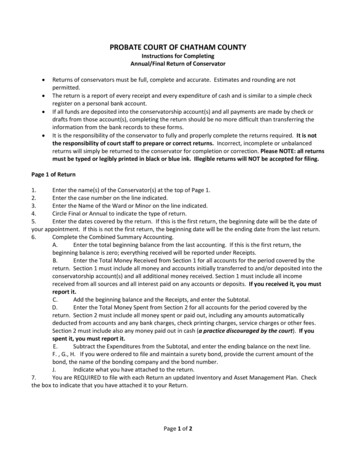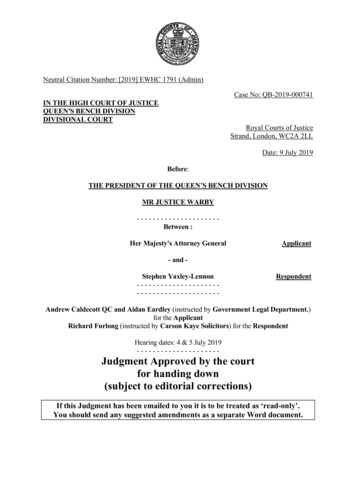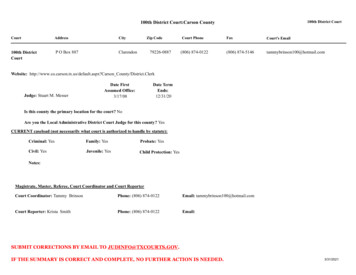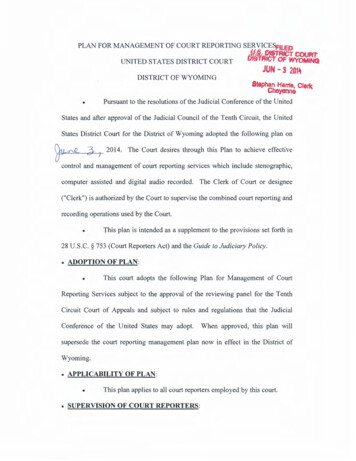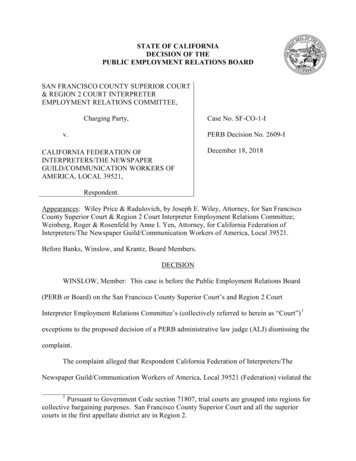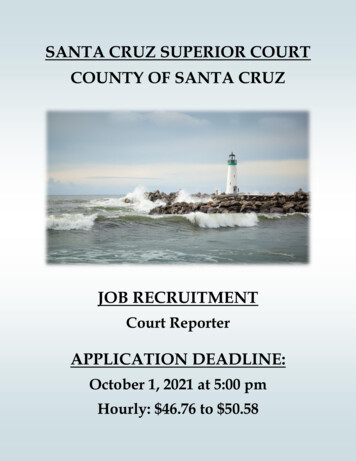
Transcription
Judgment Approved by the court for handing down.Sainsburys v MasterCard; AAM v MasterCard; Sainsbury’s v VisaNeutral Citation Number: [2018] EWCA 1536 (Civ)Case Nos: C3/2016/4250, A3/2017/0889, A3/2017/0888, A3/2017/0890 and A3/2017/3493IN THE COURT OF APPEAL (CIVIL DIVISION)ON APPEAL FROM THE COMPETITION APPEAL TRIBUNALAND ON APPEAL FROM THE HIGH COURT OF JUSTICEQUEEN’S BENCH DIVISIONCOMMERCIAL COURTTHE HONOURABLE MR JUSTICE BARLING, PROFESSOR BEATH OBE, AND MRMARCUS SMITH QCTHE HONOURABLE MR JUSTICE POPPLEWELLTHE HONOURABLE MR JUSTICE PHILLIPSClaim Nos: 1241/5/7/15(T), CL-2012-000299, CL-2012-000767, CL-2012-000959 andCL-2015-000471Royal Courts of JusticeStrand, London, WC2A 2LLDate: 4 July 2018Before:SIR TERENCE ETHERTON, MASTER OF THE ROLLSSIR GEOFFREY VOS, CHANCELLOR OF THE HIGH COURTandLORD JUSTICE FLAUXBETWEEN:SAINSBURY’S SUPERMARKETS LIMITEDClaimant/Respondent-and(1) MASTERCARD INCORPORATED(2) MASTERCARD INTERNATIONAL INCORPORATED(3) MASTERCARD EUROPE SA (formerly known as MASTERCARD EUROPESPRL)Defendants/RespondentsAND BETWEEN:(1) ASDA STORES LIMITED
Judgment Approved by the court for handing down.Sainsburys v MasterCard; AAM v MasterCard; Sainsbury’s v Visa(2) ARCADIA GROUP BRANDS LIMITED and others(3) ARGOS LIMITED and others(4) WM MORRISON SUPERMARKETS PLCClaimants/Appellants- and –(1) MASTERCARD INCORPORATED(2) MASTERCARD INTERNATIONAL INCORPORATED(3) MASTERCARD EUROPE SA (formerly known as MASTERCARD EUROPESPRL(4) MASTERCARD/EUROPAY UK LIMITEDDefendants/RespondentsAND BETWEEN:SAINSBURY'S SUPERMARKETS LIMITEDClaimant/Appellant- and (1) VISA EUROPE SERVICES LLC(2) VISA EUROPE LTD(3) VISA UK LTD(Together “VISA”)Defendants/RespondentsAND:THE EUROPEAN COMMISSIONIntervener--------------------Mr Mark Brealey QC, Mr Derek Spitz and Ms Sarah Love (instructed by Morgan, Lewis& Bockius UK LLP and Mishcon de Reya LLP) for the respondent, Sainsbury’s, inSainsbury’s v MasterCard (CAT), and for the appellant in Sainsbury’s v Visa (Phillips J)Mr Jon Turner QC, Mr Meredith Pickford QC, Mr Christopher Brown and Mr MaxSchaefer (instructed by Stewarts Law LLP) for Asda, Argos and Morrisons (the AAMparties) in AAM v MasterCard (Popplewell J)Mr Mark Hoskins QC, Mr Matthew Cook and Mr Hugo Leith (instructed by Jones Day)for the MasterCard appellants in Sainsbury’s v MasterCard (CAT), and for the MasterCardrespondents in AAM v MasterCard (Popplewell J)Ms Dinah Rose QC, Mr Daniel Piccinin and Mr Jason Pobjoy (instructed by Milbank,Tweed, Hadley & McCloy LLP and Linklaters LLP) for the Visa respondents in Sainsbury’sv Visa (Phillips J)Mr Nicholas Khan QC and Ms Ronit Kreisberger (instructed by the EuropeanCommission) for the European Commission
Judgment Approved by the court for handing down.Sainsburys v MasterCard; AAM v MasterCard; Sainsbury’s v VisaHearing dates: 16-20, 23- 27 April and 2 July 2018---------------------Approved JudgmentINDEXSectionParagraphPart I: Introduction1Part II: The essential chronological background to the three appeals12Part III: The essential reasoning of the CAT, Popplewell and Phillips JJThe CAT’s decision in Sainsbury’s v MasterCardPopplewell J’s judgment in AAM v MasterCardPhillips J’s first judgment on article 101(1) in Sainsbury’s v VisaPhillips J’s second judgment on article 101(3) in Sainsbury’s v Visa37454955Part IV: The Metropole line of authorities and the law concerningthe doctrine of ancillary restraint/ objective necessity58Part V: The law on exemption under article 101(3)75Part VI: The article 101(1) issue: Do the schemes’ rules setting defaultMIFs restrict competition under article 101(1) in the acquiring market,by comparison with a counterfactual without default MIFs where theschemes’ rules provide for settlement at par?The schemes’ arguments on article 101(1)The merchants’ arguments on article 101(1)The Commission’s arguments on article 101(1)Discussion and conclusions on article 101(1)The significance of the Commission’s decisionThe significance of the General Court’s decisionThe significance of the CJEU’s decisionConsistency between Member StatesPopplewell J’s reasoning on article 101(1)Phillips J’s reasoning on article 101(1)The CAT’s reasoning on article 101(1)The bilateral interchange fees issue in Sainsbury’s v MasterCardOur conclusions on the question of whether the schemes’ rules settingdefault MIFs restrict competition under article 101(1) in the acquiringmarket110Part VII: The ancillary restraint death spiral issueThe merchants’ arguments on the death spiral issueThe Commission’s arguments on the death spiral issueThe schemes’ arguments on the death spiral issueDiscussion and conclusion on the death spiral issuePart VIII: The article 101(3) exemption issueThe AAM parties’ appeal against Popplewell J’s decisionthat MasterCard had established exemption under article 4195198210211
Judgment Approved by the court for handing down.Sainsburys v MasterCard; AAM v MasterCard; Sainsbury’s v VisaThe relevant section of the judgmentThe AAM parties’ arguments on article 101(3)The Commission’s arguments on article 101(3)MasterCard’s arguments on article 101(3)Discussion and conclusions on the AAM parties’ appealVisa’s Respondent’s Notice in relation to Phillips J’s decisionin his second judgment that Visa’s MIFs were not exemptThe parties’ arguments on the judge’s treatment of the evidenceDiscussion and conclusions on the issue of the judge’s approachto the evidenceThe article 101(3) exemption issue in the CAT case211230236238242272274279300Part IX: The quantum issuesIntroduction to the quantum issuesDo the merchants bear the burden of proving the lawful level of MIF?Should the CAT have reduced Sainsbury’s damages for ‘pass-on’?301303315Part X: Our conclusionsThe article 101(1) issueThe bilateral interchange fees issueThe ancillary restraint death spiral issueThe article 101(3) exemption issueThe quantum issues338340341344347Part XI: The disposal of the appealsWhen proceedings can and should be transferred to the CATDisposal of the present appeals349354Annex 1: The relevant rules of the Visa and MasterCard schemesVisa’s rulesMasterCard’s rules363367Annex 2: The statutory foundationArticle 101 TFEUThe European Commission guidelines on the applicability of article101 to horizontal co-operation agreements (2011/C 11/01)The European Commission guidelines on the application of article 81(3)(now article 101(3)) (2004/C 101/08)The 1998 ActThe Irish ActAnnex 3: Summary of the Commission, General Court andCJEU decisions in MasterCardThe Commission’s decision (19 December 2007)The General Court’s decision ([2012] 5 CMLR 5 (GC))The CJEU’s decision ([2014] 5 CMLR 23 (ECJ))373377378385389391401407
Judgment Approved by the court for handing down.Sainsburys v MasterCard; AAM v MasterCard; Sainsbury’s v VisaSir Terence Etherton, Master of the Rolls, Sir Geoffrey Vos, Chancellor of the HighCourt, and Lord Justice Flaux:Part I: Introduction1.The central question in these three appeals is whether the setting of default multilateralinterchange fees (“MIFs”) within the MasterCard and Visa payment card systemscontravenes article 101 of the Treaty on the Functioning of the European Union2012/C326/01 (the “TFEU”).1 Article 101(1) provides that agreements betweenundertakings which may affect trade between Member States and which have as theirobject or effect the prevention, restriction or distortion of competition within theinternal market are prohibited as incompatible with the internal market of the EuropeanUnion. Section 2 of the Competition Act 1998 (the “1998 Act”) makes the sameprovision in relation to agreements which may affect trade within the United Kingdom,and which prevent, restrict or distort competition within the United Kingdom.2.Two of the appeals are brought from the Commercial Court, and one from theCompetition Appeal Tribunal (the “CAT”). In the broadest of outline, the CAT decidedin Sainsbury’s v MasterCard (the “CAT case” or “Sainsbury’s v MasterCard”) that theMIFs charged within the MasterCard payment system were prohibited anti-competitiveagreements, whilst the two Commercial Court judges decided, for different reasons, ineach of AAM v MasterCard (the “AAM case” or “AAM v MasterCard”) and Sainsbury’sv Visa (the “Visa case” or “Sainsbury’s v Visa”) that the MIFs charged respectivelywithin the MasterCard and Visa payment systems were not prohibited anti-competitiveagreements. It falls to this court to resolve the considerable differences of approachbetween the three decisions under appeal.3.Both the MasterCard and the Visa payment card schemes are known as four-partyschemes, though there is in each case a fifth party, namely the scheme operator itself.The schemes operate in an essentially identical way, which can be represented by thefollowing diagram:It is worth acknowledging at the outset that the term “default MIFs” is to a certain extent tautologous, since“multilateral” interchange fees are by their nature imposed by default, in the absence of an agreement as to abilateral interchange fee. We will nevertheless use the term “default MIFs” since others have repeatedly done so,and it reminds the reader of the nature of the MIFs in question.1
Judgment Approved by the court for handing down.4.Sainsburys v MasterCard; AAM v MasterCard; Sainsbury’s v VisaThe essentials of the four-party payment card scheme can be summarised as follows:i)The cardholders contract with one of many issuers as to the terms on which theymay use the card issued to them to buy goods from merchants.ii)Multiple issuers (mostly banks) contract with multiple acquirers (also mostlybanks) to settle the transactions by which cardholders “buy” goods or servicesfrom merchants using a payment card on the basis of the rules of the relevantscheme. The scheme rules provide that the issuer will pay the acquirer the valueof the cardholder’s transaction, (normally) minus the interchange fee due underthe terms of the scheme. In these schemes, the positive interchange fee isdeducted from the payment by the issuer, but that is not universally the case. Itis accepted that schemes can operate without an interchange fee, and that insome countries interchange fees are negative (i.e. added to the payment by theissuer).iii)The acquirers contract with the merchant on the basis that they will pay themerchant the value of the cardholder’s transaction minus a merchants’ servicecharge that normally includes (i) the interchange fee, (ii) the scheme fee payableby the acquirer to the scheme, and (iii) an acquirer’s margin.The details of the Visa and MasterCard Scheme Rules are set out in annex 1 to thisjudgment. It should also be noted that both schemes operated an “Honour All CardsRule”, which required merchants who accepted scheme cards to accept scheme cardsissued by all participating issuers.5.It is at this stage important to note that these appeals are not concerned with three-partypayment card schemes such as that operated in the UK by American Express and DinersClub. In that type of scheme, the scheme operator (American Express or Diners Club)itself deals directly with both cardholders and merchants, each of which pay it a fee.Payments are cleared through the scheme operator itself.6.The relevant markets should also be noted. In this regard, we can gratefully adoptparagraph 47 of Phillips J’s first judgment as follows:
Judgment Approved by the court for handing down.Sainsburys v MasterCard; AAM v MasterCard; Sainsbury’s v Visa“It is common ground that four-party systems such as the [Visa] Scheme andthe MasterCard system give rise to what is described as a “two-sided market”.One side is that in which Issuers compete with each other for the business ofcustomers to whom they will issue cards (“the issuing market”), the other isthat in which Acquirers compete for the business of Merchants (“the acquiringmarket”). The two sides are closely linked and dependent on each other: thevalue of a Visa card to a cardholder is dependent on the extent to which it isaccepted by Merchants and, correspondingly, the benefit Merchants gain fromaccepting Visa cards is dependent on the extent that consumers have and usethose cards. Precisely what benefits Merchants gain from card transactions isa matter of dispute, but it is common ground that they benefit at least to theextent that card transactions are cheaper for them than cash transactions,involving the time costs, increased staff costs and bank charges of handlingand banking cash.”7.Each of the appeals raises three primary issues which can be expressed shortly.2i)The article 101(1) issue: Do the schemes’ rules setting default MIFs restrictcompetition under article 101(1) in the acquiring market, by comparison with acounterfactual without default MIFs where the schemes’ rules provide for theissuer to settle the transaction at par (“settlement at par” or “SAP”) (i.e. to paythe acquirer 100% of the value of the transaction)?3ii)The ancillary restraint death spiral issue: Should the schemes’ argument thatthe setting of a default MIF is objectively necessary for their survival beevaluated on the basis of a counterfactual that assumes that the rival schemewould be able to continue to impose (unlawful) MIFs? This issue is known asthe “death spiral” issue because, if the counterfactual assumes a rival schemethat can continue to set high MIFs, the scheme under scrutiny would be likelyto lose most or all of its business to the rival scheme, where issuers receivedhigh MIFs and cardholders received benefits as a result.4iii)The article 101(3) exemption issue: If the setting of default MIFs infringesarticle 101(1), should it have been held that the four conditions required for theapplication of the exemption in article 101(3) were applicable in these cases,and if so at what level(s) were the MIFs exemptible? It is common ground thatthe four conditions that must be met in order for the article 101(3) exemption tobe engaged are that: (1) the agreement, decision or concerted practice mustcontribute to improving the production or distribution of goods, or to promotingtechnical or economic progress; (2) consumers must receive a fair share of theresulting benefits; (3) the restrictions must be indispensable to the attainment ofthese objectives; and (4) the agreement, decision or concerted practice must notafford the parties the possibility of eliminating competition in respect of a2We have not adopted the list of issues agreed between the parties, because, as it seems to us, itovercomplicates the issues that we have to decide. Our approach has been to reduce to the greatest extent possible,the complexities of the appeals from three conflicting decisions.3It will become clear in due course that there is no material difference between a rule requiring settlementat par and a rule prohibiting ex post pricing. The European institutions have generally referred to the latter, butthe parties in this case have agreed to refer to the former in this primary issue.4The death spiral argument was considered by both the CAT and by Popplewell J in considering the article101(1) issue as well as the arguments on “ancillary restraint” or “objective necessity”. We will, therefore, dealwith these arguments, as appropriate, under both headings.
Judgment Approved by the court for handing down.Sainsburys v MasterCard; AAM v MasterCard; Sainsbury’s v Visasubstantial part of the products in question. Only the application of the firstthree conditions has been in issue in this case.8.The other significant issues that arise are as follows:i)The bilateral interchange fees issue: Was the CAT right to employ acounterfactual that assumed that issuers and acquirers would agree bilateralinterchange fees in the absence of MIFs? We shall deal with this issue in thecourse of our treatment of the article 101(1) issue.ii)The quantum issues: Should any damages to which the merchants are entitledbe reduced or eliminated because they passed the MIFs on to their customers?iii)The disposition issue: How should the court dispose of each of the cases in thelight of its decisions on the other issues?9.We have made every attempt in the judgment to use plain intelligible language ratherthan jargon. Some of what is written in this area of the law can be confusing, notbecause the concepts are particularly difficult, but because the premise for eachproposition is not properly explained. We shall try to avoid that situation.10.The detailed statutory foundation to the issues under consideration in these appeals isset out in annex 2 to this judgment. Annex 2 includes the relevant provisions of theTFEU, the 1998 Act, the European Commission’s Guidelines (the “Guidelines”) onwhich all parties placed considerable reliance, and the (Irish) Competition Act 2002(the “Irish Act”).11.The approach adopted in this judgment is to deal with matters in the following order:Part II: The essential chronological background to the three appeals.Part III: The essential reasoning of the CAT, Popplewell and Phillips JJ.Part IV: The Metropole line of authorities and the law concerning the doctrine ofancillary restraint/ objective necessity.Part V: The law on exemption under article 101(3).Part VI: The article 101(1) issue and the bilateral interchange fees issue.Part VII: The ancillary restraint death spiral issue.Part VIII: The article 101(3) exemption issues.Part IX: The quantum issues.Part X: Our conclusions.Part XI: The disposal of the appeals.Annex 1: The relevant rules of the Visa and MasterCard schemes.Annex 2: The statutory foundation.Annex 3: A brief summary of the decisions of the European Commission, the GeneralCourt and the Court of Justice of the European Union (“CJEU”) in MasterCard.
Judgment Approved by the court for handing down.Sainsburys v MasterCard; AAM v MasterCard; Sainsbury’s v VisaPart II: The essential chronological background to the three appeals12.On 24 July 2002, the European Commission (the “Commission”) decided that Visa’sintra-European Economic Area MIFs (“EEA MIFs”) were restrictive of competition forthe purposes of what is now article 101(1), but would be exempt for a period of 5 yearsunder what is now article 101(3), subject to undertakings from Visa (the “VisaExemption Decision”). Visa undertook that it would: (i) reduce its EEA MIFs over theperiod so that (on a weighted average basis) debit and credit card transactions wouldrespectively attract maximum MIFs of 0.28 and 0.7% of transaction value; (ii) furtherensure that its MIFs did not exceed the sum of three defined categories of issuer costs,about which data was to be collected; (iii) make information available to merchantsabout MIF levels and the issuer cost percentages on which these were based; and (iv)differentiate MIFs for mail order and telephone transactions from those for face-to-facetransactions (the “Visa Exemption”). MasterCard was not bound by this decision, anddid not respond by reducing its EEA MIFs.13.On 6 September 2005, the Office of Fair Trading (“OFT”) decided that MasterCard’sintra-UK MIFs (“UK MIFs”) restricted competition under article 101(1) and were notexempt under article 101(3). MasterCard appealed the OFT’s decision to the CAT,with Visa Europe intervening and making submissions. In response to the appeal, theOFT attempted to alter the factual basis on which it had arrived at its decision againstMasterCard, and subsequently withdrew its decision on procedural grounds, as the CATformally confirmed on 10 July 2006 ([2006] CAT 14). The OFT, and its successor theCompetition and Markets Authority (“CMA”), continued to investigate MasterCard’sand Visa’s UK MIFs.14.On 19 December 2007, the Commission decided that MasterCard’s EEA MIFs had,since 22 May 1992, been in breach of article 101(1), and MasterCard had not proved tothe requisite standard that any of the first three article 101(3) exemption criteria weremet (the “Commission’s decision”). MasterCard appealed the Commission’s decisionto the General Court, and in the meantime reduced its EEA MIFs to zero. Visa did notrespond by reducing its EEA MIFs.15.The Visa Exemption expired on 31 December 2007 and, in 2008, the Commissionrecommenced its investigation into Visa’s EEA MIFs. In September 2008, it informedVisa that it favoured the Merchant Indifference Test (or MIT) for assessing whether itsMIFs were lawful, rather than the issuer-based costs methodology previously used(including in the Visa Exemption Decision) (the “Issuer Costs Methodology”). On 3April 2009, the Commission sent a Statement of Objections to Visa Europe concerningits EEA MIFs.16.Meanwhile, MasterCard and Visa had been discussing their EEA MIFs with theCommission. In July 2009, MasterCard increased its EEA MIFs from zero to 0.3% forcredit cards and 0.2% for debit cards. On 8 December 2010, the Commission adopteda decision accepting commitments offered by Visa regarding its EEA debit card MIFs.The decision (i) required Visa to reduce its weighted average EEA debit MIF to 0.2%,(ii) recorded the allegation that the MIFs had both the object and effect of restrictingcompetition, and (iii) without making a finding on liability, and subject to compliancewith the decision, held that the Commission would not take further action against Visain relation to its EEA debit MIFs.17.On 23 May 2012, Asda and Morrisons each issued claims against MasterCard in theCommercial Court. Both claims were for damages for infringements of article 101, the
Judgment Approved by the court for handing down.Sainsburys v MasterCard; AAM v MasterCard; Sainsbury’s v Visa1998 Act and article 53 of the Agreement on the European Economic Area, in respectof MasterCard’s UK MIFs since 23 May 2006 and EEA MIFs since 23 May 2007.18.On 24 May 2012, the Commission’s decision was upheld on appeal by the GeneralCourt ([2012] 5 CMLR 5) (the “General Court’s decision”). MasterCard appealed theGeneral Court’s decision to the CJEU.19.On 30 July 2012, the Commission sent a Supplementary Statement of Objections toVisa Europe concerning its EEA credit MIFs and certain other of its cross-borderacquiring (“CBA”) rules.20.On 5 October 2012, Argos issued a claim against MasterCard in the Commercial Court.The claim was for damages for infringements of article 101, the 1998 Act, article 53and section 4 of the Irish Act, in respect of MasterCard’s UK MIFs since 5 October2006, EEA MIFs since 5 October 2007, and Irish domestic MIFs between 5 October2006 and 5 January 2007 and since 20 January 2009 (see Popplewell J’s judgment at[26] for an explanation of the claim period relating to the Irish MIFs).21.On 19 December 2012, Sainsbury’s issued a claim against MasterCard in the ChanceryDivision. The claim was for damages for infringements of article 101, the 1998 Actand article 53, in respect of MasterCard’s UK MIFs since 19 December 2006 (or 19December 2007 in respect of transactions in Scotland).22.In July 2013, the Commission published a proposal for a regulation capping interchangefees across Europe. To verify the levels of the proposed caps under the MIT, theCommission conducted (with assistance from Deloitte) a survey of EEA merchants’costs data. 254 merchants from 10 EEA states responded, and the final survey report(the “Commission Survey”) was published on 18 March 2015.23.On 18 December 2013, Sainsbury’s issued its claim against Visa in the ChanceryDivision (which was subsequently transferred to the Commercial Court by consent).The claim was for damages for infringements of article 101 and the 1998 Act, in respectof Visa’s UK MIFs since 18 December 2007.24.On 26 February 2014, the Commission accepted an offer made by Visa that it wouldamend its CBA rules from 1 January 2015 to allow cross-border acquirers to electbetween (i) the local domestic MIF rate or (ii) respective rates of 0.2% and 0.3% fordebit and credit card transactions, and that it would cap its EEA credit MIFs at aweighted average of 0.3%.25.In September 2014, the CMA announced that, due to the imminent European regulationcapping interchange fees, its investigations into MasterCard’s and Visa’s UK MIFswere at an end.26.On 11 November 2014, the CJEU dismissed MasterCard’s appeal from the GeneralCourt’s decision ([2014] 5 CMLR 23) (the “CJEU’s decision”).27.On 1 December 2015, Barling J made an order transferring Sainsbury’s claim againstMasterCard from the Chancery Division to the CAT pursuant to section 16 of theEnterprise Act 2002 (the “2002 Act”). His reasons for making the order are containedin his judgment of the previous day ([2015] EWHC 3472 (Ch)) (“Barling J’s transferjudgment”).28.On 8 June 2015, the EU’s regulation on interchange fees for card-based paymenttransactions (Regulation (EU) 2015/751) (the “Interchange Fee Regulation”) came into
Judgment Approved by the court for handing down.Sainsburys v MasterCard; AAM v MasterCard; Sainsbury’s v Visaforce. Articles 3 and 4 respectively of the Interchange Fee Regulation set a maximumweighted average rate cap of 0.2% on domestic and cross-border debit MIFs, and amaximum ad valorem rate cap of 0.3% on domestic and cross-border credit MIFs, witheffect from 9 December 2015. Member States may impose lower caps for domestictransactions, but the UK has not done so. Ireland has imposed a lower debit cardinterchange fee of 0.1%. Both MasterCard and Visa have had to reduce their debit andcredit UK MIFs to comply with these caps. The CAT took the view at [17(4)(iii)] ofits decision that “it was common ground, or at least not contested by Sainsbury’s” thatSainsbury’s could not claim in respect of transactions made after 9 December 2015.29.On 14 July 2016, the CAT (Barling J, Professor John Beath OBE and Mr Marcus SmithQC) upheld Sainsbury’s claim against MasterCard, and awarded damages of 68,582,245 (subsequently adjusted to take account of the impact of corporation tax).30.On 4 August 2016, MasterCard sought permission to appeal the decision of the CATon 5 grounds, two of which related to liability and three of which related to quantum.Permission was refused by the CAT in respect of all 5 grounds on 22 November 2016.31.On 30 January 2017, Popplewell J dismissed the AAM parties’ claims againstMasterCard (viz those issued by Asda, Argos and Morrisons, which had by this timebeen combined) on the basis that MasterCard’s MIFs did not infringe article 101(1),and in any event would have been exempt under article 101(3). On 16 February 2017,he refused permission to appeal.32.On 16 August 2017, Beatson LJ granted the AAM parties permission to appealPopplewell J’s judgment on most, but not all, of their proposed grounds. On the sameday, he granted MasterCard permission to appeal the CAT decision, in respect of all itsgrounds.33.On 30 November 2017, Phillips J dismissed Sainsbury’s Commercial Court claimagainst Visa on the basis that Visa’s MIFs did not infringe article 101(1). The judgegranted Sainsbury’s permission to appeal, and indicated that he would address thearticle 101(3) issues in a further judgment.34.On 15 December 2017, Flaux LJ ordered that the Sainsbury’s appeal against thedecision of Phillips J would be heard at the same time as the appeals against thedecisions of the CAT and Popplewell J.35.On 23 February 2018, Phillips J gave a further judgment in which he held that, had hereached a different view on the article 101(1) question, Visa’s MIFs would not havebeen exempt (at any level) under article 101(3).36.On 8 March 2018, Flaux LJ granted the Commission permission to intervene in theappeals pursuant to article 15(3) of Regulation 1/2003 (the “ModernisationRegulation”). He also allowed the Commission to make oral submissions at thehearing.Part III: The essential reasoning of the CAT, Popplewell and Phillips JJThe CAT’s decision in Sainsbury’s v MasterCard37.After setting out the facts, issues and evidence in some detail, the CAT decided twoissues which are no longer in dispute. At [85]-[95], it held that the setting of the UKMIF was a decision or series of decisions by the MasterCard entities as an association
Judgment Approved by the court for handing down.Sainsburys v MasterCard; AAM v MasterCard; Sainsbury’s v Visaof undertakings. This is not appealed by MasterCard, and Visa did not seek to arguethe contrary before Phillips J. At [97]-[102], the CAT held that the MIF did not amountto a restriction of competition by object. This is not appealed by Sainsbury’s, and theAAM parties did not pursue a similar line of argument before Popplewell J.38.The CAT next turned to the question whether the MIFs amounted to a restriction ofcompetition by effect within the meaning of article 101(1). As for the counterfactualagainst which their restrictive effects were to be tested, the starting point was a rule thatMasterCard transactions would be settled at par, which was equivalent to a default MIFof zero ([141]-[143]). The CAT rejected a submission by Sainsbury’s that Visa shouldbe assumed to have introduced a similar rule: the CAT reasoned that it was the effectsof the MasterCard scheme that were being tested, and it would be wrong to make anypresumptions regarding Visa that were not grounded in fact ([159]).39.As to what Visa would have “actually” done in the counterfactual world, the CATthought that it would have maintained its MIFs as close to their then level as it felt itcould achieve ([160]-[163]). The CAT considered that for the following reasons, thiswould not have resulted in issuing banks immediately leaving the MasterCard schemedue to the higher MIFs offered by Visa; rather, they would have sought bilaterally toagree interchange fees with acquirers ([174]-[178]). Although it would have been opento acquirers to refuse to agree anything (resulting in a zero MIF attractive to theirmerchant customers), they would not have taken this course for fear of (i) a Visamonopoly as issuers switched schemes and (ii) issuers withdrawing valuable benefitsor features of the scheme in response to reduced MIFs ([182]-[197]). Instead, theywoul
Judgment Approved by the court for handing down. Sainsburys v MasterCard; AAM v MasterCard; Sainsbury's v Visa The relevant section of the judgment 211 The AAM parties' arguments on article 101(3) 230 The Commission's arguments on article 101(3) 236 MasterCard's arguments on article 101(3) 238 Discussion and conclusions on the AAM parties' appeal 242




